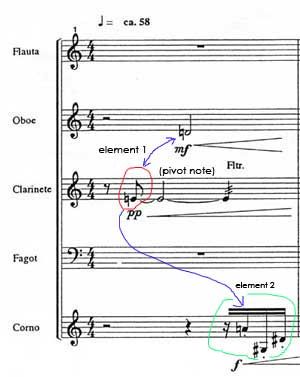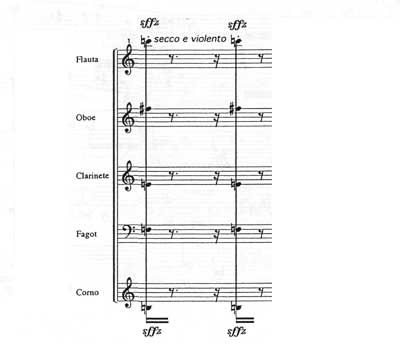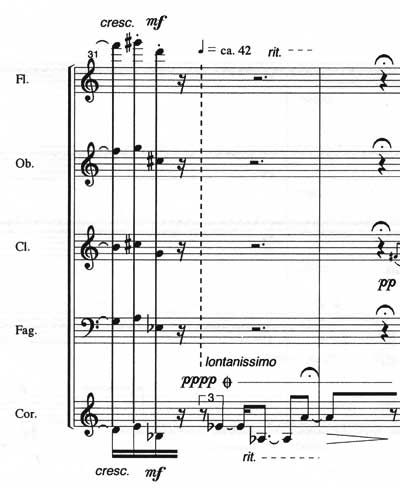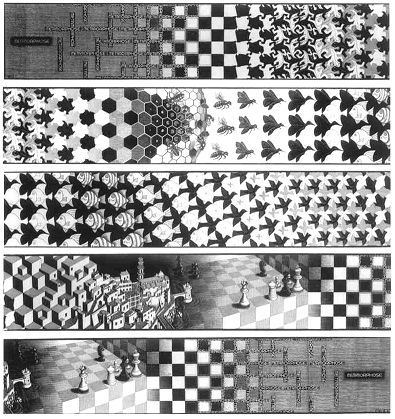
Title of the work: Quinteto (1994).
Composer: Javier Torres Maldonado.
Duration: 5'.
Publisher: Edizioni Suvini Zerboni - Milano (for more information please send an e-mail to my publisher).
Year of composition: 1994.
World premiere: Mexico City, Auditorio “Simón Bolivar”, May 1995 - BSM Quintet.
Score (only with authorization)
It was composed in December 1994. It is the first piece to appear in the composer’s catalog. This work arises from the contact with the composer Franco Donatoni, to whom Torres Maldonado was introduced that year in Mexico City, during one of the trips that the Italian composer made to Mexico.
The piece consists of 7 variations, in which Torres Maldonado adopts and personalizes some of the donatonian techniques with very interesting results. In this first composition Torres Maldonado outlines some of the characteristics to be found on later works, such as: the conception of different rhythmic dimensions of the same musical object, the work with very few elements and the interest taken in gradual transitions from one initial “state” of the sonority to another completely different.
In the first section the basic material is exposed. It consists of a cell of five notes separated by intervals of mayor second (oboe and clarinet), perfect fifth (oboe and horn), minor ninth and perfect fifth (three notes played by the horn), respectively:

It is followed by 6 variations bordered by sffz chords that work as signals whose characteristic sonority is derived precisely from the cell which constitutes the material described above:

The first 4 variations take their material from the gesture presented in the first two measures (Figures 1 and 2) and from the figure that precedes the beginning of each variation, as happens in the “staccati” variation which begins on bar 17 –rehearsal mark “C”-.
A technical aspect that is important to emphasize, is that inside the basic derivation cell there is a polarized note (E) that functions as a pivot note for each harmonic derivation that follows, and constitutes another clear formal sign (see the Figure 1.) Both in the initial section and the first four variations the composer assigns this central E individually to every instrument of the quintet. This note will appear at the beginning of the corresponding variation or at the end of the previous one in the following order:
1. Initial section: clarinet
2. I Variation: horn
3. II Variation: (precedes the variation) Basoon
4. III Variation: oboe
5. IV Variation: (precedes the variation) Flute.
Starting from measure 25 in the fifth variation, -above the E which expands in its harmonic spectrum in the flute, almost as if trying to free itself from the obstinate pitch fixation in which it has been kept from the beginning of the piece- starts a parallel chords variation that certainly constitutes the section that can be considered closest to Donatoni from the 80’s and 90’s. Nevertheless we can find on this variation some elements that separate it from Donatoni’s poetics, such as the abrupt metronomic change on measure 32, in which an element is introduced in “pianissimo” and “ritardando” by the horn; an element isolated from the basic derivation cell which was already introduced precisely by the horn in the first measure and that is used in this fifth variation to open a surprising internal parenthesis:

In the sixth variation the chords are fragmented in trilled notes that are gradually diminished rhythmically until every instrument coincides in the “sign” chord (in which every note is trilled), preceding one of the most interesting moments of the work: the seventh variation.
This last variation was constructed using a procedure that was named by the composer ”rhythmic-intervallic stretto”. This procedure was used again by Torres Maldonado two years later in the final section of Figuralmusik I (1996). The composer describes this technique as a gradual transformation of the monolithic figure element until it is shattered or transformed into something extremely different, somewhat like the fabulous transitions that Marc Escher produced in some of his works, where the sea is turned into birds while the air is transformed into fish, and the chess board that metamorphoses into something completely different.The next animation (it is a video link from youtube) is a good example of the works on a transition, typical of some pictures of M. C. Escher:

The composer begins with a monolithic state of the sound material. This material is then transformed so gradually that becomes difficult for the listener to realize the moment in which the changes are taking place. Nevertheless the composer doesn’t need more than 7 or 8 measures to complete this process. At the beginning of the variation each instrumental line corresponds to an intervallic typology derived from a single interval from those that constituted the basic derivation cell (minor seconds, major seventh, etc). An invariable rhythmic value is assigned to each one of the intervals, generally derived from the regularity found within an irregular rhythmic figure (triplets, etc). The transformation comes in the moment in which those values initially invariable –rhythm and pitch- are progressively diminished. In this particular passage the composer starts with figures slightly smaller or bigger than the quarter that corresponds to the measure’s beat, and arrives to the tuplets in the clarinet, oboe and flute which are abruptly interrupted by the same note E that was fixed in its register during the first variations, and this time exposed by the horn as a final sign that comes before the last series of figures leading to the last derivation of the final chord.